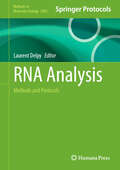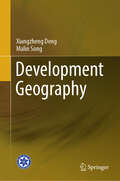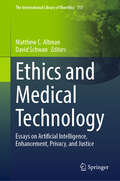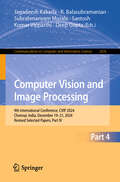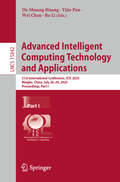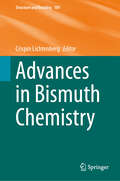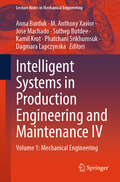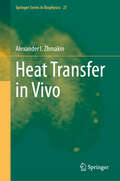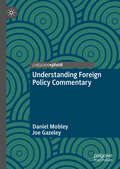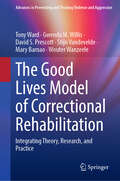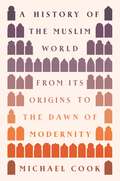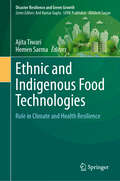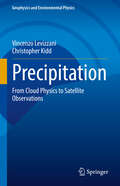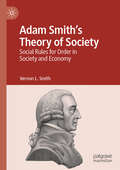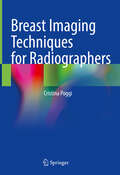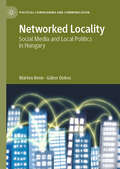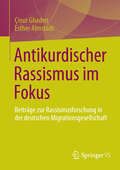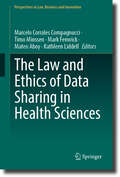- Table View
- List View
Green Energy Investments and Economic Development (Sustainable Development Goals Series)
by Ramesh Chandra DasIn an era where economic progress and environmental sustainability must go hand in hand, this book offers an essential exploration of how renewable energy can drive both growth and sustainability. It delves into the pivotal role of green energy investments in achieving the United Nations' Sustainable Development Goal 7 (SDG 7)—ensuring access to affordable, reliable, and sustainable energy for all. With 25 well-researched chapters, the book provides a comprehensive analysis of green energy's impact on economic development, circular economy principles, and productivity of energy resource. Through theoretical models and empirical studies, it presents a cross-country analysis, offering valuable insights for policymakers, researchers, economists, and environmentalists. It highlights the necessity of transitioning from fossil fuels to renewable energy and explores strategies for mitigating climate change through public and private sector collaborations. As nations strive to balance industrial growth with environmental responsibility, this book serves as a vital resource for scholars and decision-makers looking to implement sustainable energy solutions. Whether you are a researcher in economics, environmental science, or social sciences, or a policymaker shaping the future of green development, this book equips you with the knowledge and tools to drive impactful changes.
RNA Analysis: Methods and Protocols (Methods in Molecular Biology #2962)
by Laurent DelpyThis volume explores the latest technologies for RNA analysis, covering fundamental techniques and innovative approaches that expand our understanding of RNA biology. The chapters in this book are organized into four parts: reverse transcription and RNA capture methods; high-throughput sequencing methods; RNA maturation: splicing, polyadenylation, and epitranscriptomic modifications; and RNA surveillance: nonsense-mediated mRNA decay. These chapters aim to provide detailed protocols for select techniques used by molecular and computational biologists to isolate, amplify, detect, modify, and analyze RNA to gain insight into a wide range of cellular functions. Written in the highly successful Methods in Molecular Biology series format, chapters include introductions to their respective topics, lists of the necessary materials and reagents, step-by-step, readily reproducible laboratory protocols, and tips on troubleshooting and avoiding known pitfalls.Cutting-edge and comprehensive, RNA Analysis: Methods and Protocols is a valuable resource for students, technicians, and senior scientists who want to learn more about this dynamic field of RNA research.
Primer on Urology
by Alan J. Wein Christopher R. ChappleThe Primer on Urology is an entirely new approach to reviewing the field of urology.The principle is to cover the whole subject of urology in an up-to-date textbook, with not only chapters written by key opinion leaders within Europe but also a significant commentary on each section from a senior North American urologist. The book is based on the European Association of Urology Guidelines, which are updated regularly with a new release every year.This will be a valuable book for anybody interested in urology but is designed in particular for the resident as well as the practising urologist who wants a crisp update of the latest developments in the field as well as the basic knowledge, all of which is succinctly presented with reference to the latest evidence-based approach to the subject.
Development Geography
by Xiangzheng Deng Malin SongThis book provides practical insights into regional development, focusing on how economic, social, and environmental factors contribute to disparities across regions. It examines pressing global issues such as income inequality, climate change, and sustainable growth, offering strategies for addressing these challenges in both developed and developing countries. The book combines theoretical frameworks with case studies, policy analysis, and interdisciplinary methods, making it both academically rigorous and highly applicable for real-world solutions. Key features include in-depth regional comparisons, climate adaptation strategies, and detailed policy recommendations. The reader will gain a comprehensive understanding of how to navigate the complexities of regional development and implement effective, sustainable policies. Ideal for scholars, policymakers, and development practitioners, this book is designed to inspire informed decision-making and foster balanced growth across regions.
Ethics and Medical Technology: Essays on Artificial Intelligence, Enhancement, Privacy, and Justice (The International Library of Bioethics #113)
by Matthew C. Altman David SchwanThis book provides a comprehensive survey of ethical issues raised by advanced medicaltechnologies. The field&’s leading authorities explore how artificial intelligence, telehealth,robot caregivers, genetic therapies and enhancement, stem cell research,neurotechnology, electronic health records, data collection, and digital nudging arereshaping the landscape of medical practice. Organized around core ethical themes, thechapters consider how new and emerging technologies transform personal identity, the provider-patient relationship, privacy and autonomy, and social equity. Contributors clarifythe complex values involved in medical innovation and practice, and explore what is atstake in the current ethical debates around these issues. While offering a valuableintroduction for advanced students, professional philosophers, medical ethicists, andpolicymakers, this book also advances the scholarly discussion by presenting originaltheses and arguments, making it essential reading for specialists.
Computer Vision and Image Processing: 9th International Conference, CVIP 2024, Chennai, India, December 19–21, 2024, Revised Selected Papers, Part IV (Communications in Computer and Information Science #2476)
by R. Balasubramanian Santosh Kumar Vipparthi Subrahmanyam Murala Deep Gupta Jagadeesh KakarlaThe Six-volume proceedings set CCIS 2473 and 2478 constitutes the refereed proceedings of the 9th International Conference on Computer Vision and Image Processing, CVIP 2024, held in Chennai, India, during December 19–21, 2024. The 178 full papers presented were carefully reviewed and selected from 647 submissions.The papers focus on various important and emerging topics in image processing, computer vision applications, deep learning, and machine learning techniques in the domain.
Advanced Intelligent Computing Technology and Applications: 21st International Conference, ICIC 2025, Ningbo, China, July 26–29, 2025, Proceedings, Part I (Lecture Notes in Computer Science #15842)
by Wei Chen De-Shuang Huang Bo Li Yijie PanThis 20-volume set LNCS 15842-15861 constitutes - in conjunction with the 4-volume set LNAI 15862-15865 and the 4-volume set LNBI 15866-15869 - the refereed proceedings of the 21st International Conference on Intelligent Computing, ICIC 2025, held in Ningbo, China, during July 26-29, 2025. The total of 1206 regular papers were carefully reviewed and selected from 4032 submissions. This year, the conference concentrated mainly on the theories and methodologies as well as the emerging applications of intelligent computing. Its aim was to unify the picture of contemporary intelligent computing techniques as an integral concept that highlights the trends in advanced computational intelligence and bridges theoretical research with applications. Therefore, the theme for this conference was "Advanced Intelligent Computing Technology and Applications".
Anne de France and Her Family: Genealogies of Premodern Gendered Power and Influence (Queenship and Power)
by Zita Eva RohrThis book demonstrates that premodern elite and royal women were critical to the geopolitical success of late medieval territorial monarchies, the progenitors of early modern states. It aims to communicate the 'un-exceptionality' of female political influence in medieval and early modern Europe. Manifesting sophisticated and informed leadership in times of challenge and transformation, women such as Anne de France, her matrilineal line, and the elite women and girls in her orbit were key to early modern government, politics and diplomacy. Through a longue durée case study, this book examines generations of a premodern matriline culminating in Anne, beginning with Elisabetta di Carinzia and her daughter, Elionor de Sicília, continuing with Elionor's daughters-in-law, moving into the territories of the insular and peninsular kingdoms of Naples, into France with Elionor's granddaughter, Yolande d'Aragon, and into England with Yolande&’s granddaughter, Marguerite d'Anjou, to influence and underwrite powerful and influential territorial monarchies. Together, these women, and the others discussed in this study, form an important part of Anne de France&’s matrilineal heritage, providing her with a historical template of lived political experience on which to construct her own gendered political theory and practice.
Prospects of Fungal Biotechnologies for Livestock Volume 1: Fungal Bioengineering in Livestock Health Management (Fungal Biology)
by Arti GuptaThis multi-volume set covers a great amount of research done on fungal infection, emphasizing relevant data in the discussion. It is intended to address the major causes of fungal biotechnological aspects while bringing in the most recent data concerning discoveries in livestock management. Each volume in the set will give readers the necessary information, complemented by areas of focus of the accompanying volumes. The set covers topics spanning from basic concepts to health management to engineering using cell lines and approaching bioprocess technology, with a particular focus on recent developments. Volume 1 discusses the different ways in which fungal biotechnologies can be used to improve livestock health, including through the use of probiotics and biocontrol agents. How assisted reproduction technologies have played a crucial role in enhancing livestock production from a domestic practice to a commercial enterprise is addressed in this publication.The book also delves into the current therapy applied to deal with fungal infections, as well as innovations in the livestock field. Lastly this book touches upon the potential economic benefits that these biotechnologies can bring to farmers and stakeholders.
Von der Aufklärung zur Postmoderne: Stadt, Architektur, Gesellschaft
by Gert KählerDie Aufklärung Mitte des 18. Jahrhunderts schuf eine Architektur auf der Grundlage der Rationalität - den Klassizismus. Die sich verändernde Gesellschaft stellte aber Anforderungen, die mit den traditionellen Methoden gar nicht lösbar waren - Industrialisierung und Bevölkerungswachstum musste in traditionelle Architekturkonzepte überführt oder völlig neu gedacht werden. Die großen Umbrüche am Beginn des 20. Jahrhunderts, Industrialisierung und Kriege, und eine sich verändernde Gesellschaft zeigten, dass der Versuch, einen Stil für alle zu entwickeln, zum Scheitern verurteilt war. Die Moderne trat mit diesem Ansatz an - ein neuer, voraussetzungsloser Stil für eine neue Gesellschaft -, musste aber scheitern. Heute stellen sich ganz andere als Stilfragen: Die Entwicklung weg von einer Stadt für alle hin zum Ort einer Zweidrittel-Gesellschaft.
Advances in Bismuth Chemistry (Structure and Bonding #189)
by Crispin LichtenbergThis volume provides a comprehensive exploration of the diverse facets of bismuth chemistry. It covers topics such as the influence of nitrogen-based ligands on bismuth coordination chemistry, the structural constraints affecting bismuth compounds, and the reactivity of bismuthinidenes. Additionally, the book presents the properties and significance of low-valent molecular bismuth species, including neutral Bi(I) and Bi(II) species, molecular Bi-clusters, and radicals, as well as their potential applications in catalysis. Furthermore, it examines the role of bismuth compounds in endeavors towards more sustainable organic synthesis. This book is a valuable resource to researchers, graduate students and professionals interested in inorganic chemistry at the interface with organic synthesis, particularly those focusing on bismuth chemistry, ligand design, and reactivity studies.
Intelligent Systems in Production Engineering and Maintenance IV: Volume 1: Mechanical Engineering (Lecture Notes in Mechanical Engineering)
by Anna Burduk Jose Machado Suthep Butdee Phatchani Srikhumsuk M. Anthony Xavior Kamil Krot Dagmara LapczynskaThis book reports on intelligent systems and methods applied to engineering production and maintenance. Being the first of two volumes, it specifically focuses on advanced tools for analysing, designing and optimizing manufacturing processes, increasing their automation, safety, and sustainability. It also covers applications of intelligent methods for improving transport systems, discussing topics in mechanical engineering education alike. Based the 5th International Conference on Intelligent Systems in Production Engineering and Maintenance, ISPEM 2025, held on June 25-27, 2025, in Wroclaw, Poland, this book offers a timely snapshot of intelligent systems applications and advances in industry 4.0 in engineering design and manufacturing.
Heat Transfer in Vivo (Springer Series in Biophysics #27)
by Alexander I. ZhmakinThis monograph discusses the physical phenomena encountered in the heat transfer in living tissues and mathematical models. It also considers all the relevant information regarding heat transfer in humans, animals and plants in nature and medicine from the whole body down to cellular and sub-cellular models. Effects of the high or low temperature on the biological systems at the different levels - cells, tissues and organisms - as well a role of the blood circulation and the structure of the vascular network on the heat transfer are considered. The classic Pennes bioheat equation, a number of the non-Fourier heat transfer models (including the single-phase-lag and dual-phase-lag models), the porous media models, the models based on the fractional differential equations, the discrete vascular models are analyzed and discussed at length. This book is particularly interesting for graduate students, postdoctoral fellows and researching working on heat transfer in biological systems.
Quantifying International Conflicts: Data on War or Data for War
by Thomas Lindemann Eric Sangar Frédéric Ramel Louise Beaumais Iris Lambert Sami MakkiBased on the Datawar research program developed by three French academic institutions, this book seeks to explore the following research question: how do social practices of data collection and analysis in quantitative conflict studies influence researchers’ and practitioners’ representations of armed conflict? The editors and authors investigate both scientific practices in the field of quantitative conflict studies and the impact of these practices on practitioners’ vision of war, covering the full lifecycle of quantitative conflict data, from collection and analysis to their use and dissemination by military and diplomatic institutions, humanitarian organizations, and the media.
Understanding Foreign Policy Commentary
by Daniel Mobley Joe GazeleyDrawing on original research, this book introduces the concept of the Foreign Policy Commentariat and explains the significance of the foreign policy commentary articulated in the pages of Foreign Policy and Foreign Affairs magazines. This commentary, presented as distinct from academic analyses, is conceptualized as a discourse that reproduces certain unproblematized understandings of how foreign policy and international relations function. Using intersectional gender and postcolonial approaches, the book examines commentary about the Obama, first Trump, and Biden administrations. Applying these critical approaches reveals the particular forms of knowledge and relationships of power reproduced through foreign policy commentary. Through challenging supposedly universal foreign policy concepts, these intersecting theories highlight how foreign policy commentary perpetuates a vaguely realist worldview which, we argue, employs theoretical concepts as facts rather than analytical tools. As its empirical analysis concludes at the end of the Biden administration, the book also documents the seeming retreat of a post-WWII US foreign policy consensus.
The Good Lives Model of Correctional Rehabilitation: Integrating Theory, Research, and Practice (Advances in Preventing and Treating Violence and Aggression)
by Tony Ward David S. Prescott Gwenda M. Willis Stijn Vandevelde Mary Barnao Wouter WanzeeleThe book examines the Good Lives Model (GLM) of correctional rehabilitation and its dual aims of risk reduction and well-being enhancement for individuals who have committed crimes. It describes the use of individuals’ prioritized values in intervention plans and to capitalize on and further develop their strengths and reduce the risk for future offending. The book directly addresses the differences between purely risk-oriented rehabilitation correctional models (e.g., Risk-Need-Responsivity Model) and strength-based approaches (e.g., GLM) and the clinical advantages of using the latter. It updates the GLM in the context of recent work in evolutionary biology, quality of life and well-being, cognitive neuroscience, developmental psychology, human rights, naturalistic ethics, criminology, desistance research, and theoretical reformulations of dynamic risk and protective factors. Case studies illustrate the detailed application of GLM evidence-based practice plans to adults convicted of crimes and demonstrate the effectiveness of GLM intervention strategies. Key areas of coverage include: GLM community and within-prison intervention strategies. Incorporating dynamic risk factors into GLM case formulations. Incorporating desistance research in postrelease planning and practice. Policy implications of the GLM. The Good Lives Model of Correctional Rehabilitation is a must-have resource for clinicians, therapists, and other professionals as well as researchers, professors, and graduate students in developmental psychology, family studies, forensic psychology, criminology/criminal justice, public health, psychotherapy/counseling, psychiatry, social work, educational policy and politics, health psychology, nursing, and behavioral therapy/rehabilitation.
Gaza Catastrophe: The Genocide in World-Historical Perspective
by Gilbert Achcar"A left-wing materialist perspective that has faded in prominence in the Arab world in recent times."―The Irish Times"Exposes the bankruptcy of Western Liberalism."―JacobinFrom a foremost expert on the Middle East—a searing indictment of the forces that led to genocidal war on Gaza and its reverberations across the globe. The destruction rained on Gaza has been seen and accepted by many as a vengeful overreaction to the reckless Hamas-led attack on October 7, 2023. This book, however, argues that the new catastrophe befalling the Palestinian people is the culmination of a decades-long pattern that runs parallel with Israel’s inexorable shift to the right. It also contends that Gaza was the final nail in the coffin of the Atlanticist "international liberal order" before Donald Trump came back to the White House. Gaza Catastrophe reckons with the lethal consequences far greater than the Nakba of 1948 and the significance of a war waged by an advanced military-industrial state—with full US participation and open support from the West. Renowned political scientist Gilbert Achcar explores the dynamics of a complex historical process that culminated in the war on Gaza and wider conflict in the Middle East. Achcar offers critical insights on the genocide’s regional and international consequences, as well as radical critiques of Zionism, Hamas, and other state and non-state actors. This volume is essential to understanding the root causes of the violence destabilizing the entire region and the wider world, as well as the conditions required to bring it to an end.
A History of the Muslim World: From Its Origins to the Dawn of Modernity
by Michael A. CookA panoramic history of the Muslim world from the age of the Prophet Muḥammad to the birth of the modern eraThis book describes and explains the major events, personalities, conflicts, and convergences that have shaped the history of the Muslim world. The body of the book takes readers from the origins of Islam to the eve of the nineteenth century, and an epilogue continues the story to the present day. Michael Cook thus provides a broad history of a civilization remarkable for both its unity and diversity.After setting the scene in the Middle East of late antiquity, the book depicts the rise of Islam as one of the great black swan events of history. It continues with the spectacular rise of the Caliphate, an empire that by the time it broke up had nurtured the formation of a new civilization. It then goes on to cover the diverse histories of all the major regions of the Muslim world, providing a wide-ranging account of the key military, political, and cultural developments that accompanied the eastward and westward spread of Islam from the Middle East to the shores of the Atlantic and the Pacific.At the same time, A History of the Muslim World contains numerous primary-source quotations that expose the reader to a variety of acutely insightful voices from the Muslim past.
Ethnic and Indigenous Food Technologies: Role in Climate and Health Resilience (Disaster Resilience and Green Growth)
by Hemen Sarma Ajita TiwariIndigenous fermented foods have long served as essential components of traditional diets across the world. These include both fermented and non-fermented varieties, often rooted in centuries-old practices of food preparation and preservation. Beyond extending shelf life, fermentation enhances the physiochemical properties and nutritional profile of food. However, with the increasing impacts of climate change, globalization, urbanization, and the rising availability of processed fast foods, many indigenous food cultures are rapidly declining. This book explores the intersection of ethnic fermented foods, global ecological change, and evolving fermentation technologies. It examines how climate variability affects traditional food systems and emphasizes the need for preserving indigenous knowledge. The volume provides in-depth insights into the biochemistry, microbiology, biotechnology, and nutritional composition of a diverse range of ethnic and indigenous fermented foods. With a focus on both traditional practices and contemporary scientific advancements, this book offers valuable perspectives on sustainable food systems, food security, and health resilience. It serves as a vital reference for researchers, academicians, and students in the fields of food science, biotechnology, microbiology, biochemistry, and environmental studies.
Precipitation: From Cloud Physics to Satellite Observations (Geophysics and Environmental Physics)
by Vincenzo Levizzani Christopher KiddThis book provides a comprehensive and in-depth exploration of the physics involved in the formation of precipitation in the Earth's atmosphere. It begins by emphasizing the significance of precipitation in the Earth system and climate. Cloud physics is incorporated to provide readers with the essential physical background necessary to understand the process of hydrometeor formation within clouds. Subsequently, the intricate structure of precipitation systems is elucidated, aiding readers in comprehending the mesoscale and synoptic characteristics of precipitation organization. The book concludes with a section on precipitation observation and measurements, which examines various sensors, such as gauges, radars, satellites, and platforms. These networks enable access to global precipitation data for meteorology and climate analysis. Designed to meet the needs of graduate and PhD students in fields such as geophysics, meteorology, climate science, hydrology, environmental sciences, water management, and geography, this book is also valuable for researchers and professionals from diverse disciplines who require a solid understanding of precipitation products for their work. Although the book requires a fundamental understanding of classical physics (including dynamics, thermodynamics, electricity, and magnetism), as well as a basic grasp of inorganic chemistry, its content remains accessible and informative for readers with diverse levels of expertise.
Adam Smith’s Theory of Society: Social Rules for Order in Society and Economy
by Vernon L. SmithMany people are intrigued by the theories of Adam Smith, particularly those found within The Theory of Moral Sentiments (TMS). The ideas in his 18th-century manuscript are abstract, dense, and philosophical. Consequently, the insights from Adam Smith can be inaccessible to those who seek to understand these teachings. This book by Vernon L. Smith clarifies and contextualizes Adam Smith's work, making it more approachable for modern readers. It provides over 400 key passages from the Douglas Stewart edition (Henry G. Bohn) of TMS, presenting these ideas with modern context from Vernon L. Smith in a clear and concise manner. The book is structured to allow readers to explore one or two passages a day, providing a gradual and thorough understanding of the ideas that influence societal order and moral foundations. Readers will gain a comprehensive understanding of Adam Smith's insights into societal order and human interaction. The book offers practical context to the 18th-century text, making it relevant for contemporary audiences, including economists, social scientists, and philosophers. By breaking down complex teachings into manageable daily readings, the book equips readers with the knowledge to appreciate and apply Adam Smith's theories in their own lives and professional fields.
Breast Imaging Techniques for Radiographers
by Cristina PoggiThis textbook is intended to give most of the information a Mammographer should have to understand and perform successfully breast imaging techniques. It is structured in 6 parts, Basic theory, Technical quality, Clinical quality, on the Report, other breast imaging techniques and Radio-Protection, Ergonomics, the academic training and the communicant skill. Every part is divided in chapters, made up of short paragraphs with very specific titles, to give the reader the opportunity to find the answer to her/his question easily. Much importance is given to the image produced, which should be characterized by a very high level of diagnostic information, to allow the reader to find the lesion, if it is there, as early as possible. The topic of how to produce the image is dealt with then, but also of how to evaluate thoroughly and appropriately the quality of it. Giving this in-depth knowledge was the aim of this work. The book covers up-to-date information about breast imaging and the surveillance pathway of the patient with breast cancer; it is therefore, of significant interest to Radiographers, Technologists, Radiologists, Breast Nurses; Radiographers students, both undergraduate and postgraduate; Physiotherapists.
Networked Locality: Social Media and Local Politics in Hungary (Political Campaigning and Communication)
by Márton Bene Gábor DobosDrawing upon extensive nationwide research in Hungary, this volume investigates how social media platforms operate as new spaces for local political interaction, community-building, and public discourse, and assesses their implications for democratic practices. At its core, this work seeks to answer fundamental questions about the nature, scale, and impact of local political engagement online. Our analysis spans micro-level interactions among individuals, meso-level storytelling agents such as community pages and political figures, and the broader context in which these dynamics unfold. Particular attention is paid to the role of political considerations, especially to how the interests of national political actors are reflected in and serve to energize local, social media-based publics. By offering detailed insights into Hungary's local social media landscape, it provides a broader understanding of the evolving role digital platforms play in shaping contemporary civic life, ultimately informing discussions about the future of community and political engagement in an increasingly digital world.
Antikurdischer Rassismus im Fokus: Beiträge zur Rassismusforschung in der deutschen Migrationsgesellschaft
by Çinur Ghaderi Esther AlmstadtÇinur Ghaderi und Esther Almstadt machen in diesem Band Diskriminierungs- und Rassismuserfahrungen von Kurd*innen in der Migrationsgesellschaft sichtbar und vermitteln Wissen zu Kurd*innen in Deutschland. Sie richten damit den Fokus auf eine Leerstelle in der ohnehin noch jungen Rassismusforschung in Deutschland. Ihre Forschungsergebnisse beruhen vor allem auf qualitativen Interviews mit Akteur*innen aus unterschiedlichen gesellschaftlichen Bereichen und einer Medienanalyse zur Darstellung von Kurd*innen, die in einen Definitionsvorschlag für Antikurdischen Rassismus münden und bildungspolitische Handlungsperspektiven eröffnen. Zielgruppen sind Studierende, Forschende, Lehrende, Praktiker*innen unterschiedlicher sozialwissenschaftlicher Disziplinen und Interessierte aus Politik und Gesellschaft, die sich über Kurd*innen in Deutschland und ihre Diskriminierungs- und Rassismuserfahrungen informieren möchten und hieraus Handlungsperspektiven entwickeln möchten.
The Law and Ethics of Data Sharing in Health Sciences (Perspectives in Law, Business and Innovation)
by Mark Fenwick Marcelo Corrales Compagnucci Timo Minssen Mateo Aboy Kathleen LiddellData sharing – broadly defined as the exchange of health-related data among multiple controllers and processors – has gained increased relevance in the health sciences over recent years as the need and demand for collaboration has increased. This includes data obtained through healthcare provisions, clinical trials, observational studies, public health surveillance programs, and other data collection methods. The practice of data sharing presents several notable challenges, however. Compliance with a complex and dynamic regulatory framework is essential, with the General Data Protection Regulation being a prominent example in a European context. Recent regulatory developments related to clinical trial transparency, trade secrecy, data access, AI training data, and health data spaces further contribute to the difficulties. Simultaneously, government initiatives often encourage scientists to embrace principles of “open data” and “open innovation.”The variety of regulations in this domain has the potential to impede widespread data sharing and hinder innovation. This edited volume, therefore, compiles comparative case studies authored by leading scholars from diverse disciplines and jurisdictions. The book aims to outline the legal complexities of data sharing. By examining real-world scenarios from diverse disciplines and a global perspective, it explores the normative, policy, and ethical dilemmas that surround data sharing in the health sciences today.Chapter Patient Perspectives on Data Sharing, Chapter Supplementary Measures and Appropriate Safeguards for International Transfers of Health Data after Schrems II are available open access under a Creative Commons Attribution 4.0 International License via link.springer.com.

